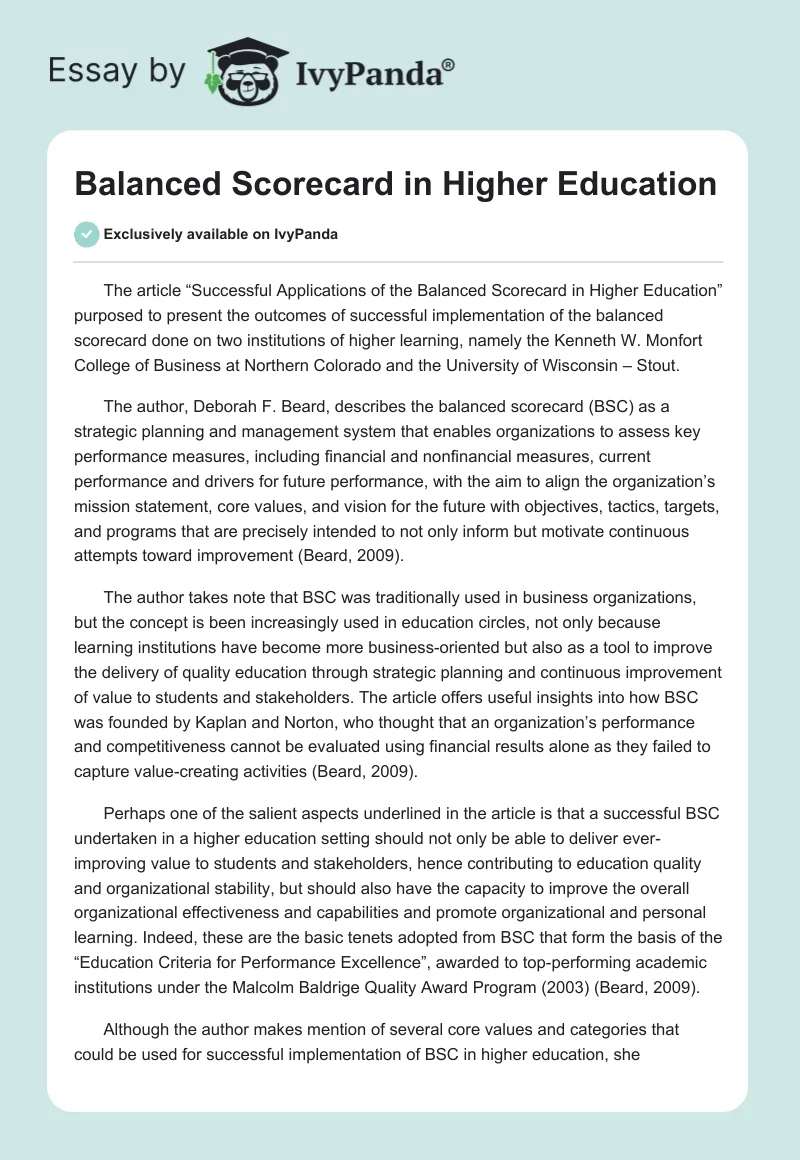The article “Successful Applications of the Balanced Scorecard in Higher Education” purposed to present the outcomes of successful implementation of the balanced scorecard done on two institutions of higher learning, namely the Kenneth W. Monfort College of Business at Northern Colorado and the University of Wisconsin – Stout.
The author, Deborah F. Beard, describes the balanced scorecard (BSC) as a strategic planning and management system that enables organizations to assess key performance measures, including financial and nonfinancial measures, current performance and drivers for future performance, with the aim to align the organization’s mission statement, core values, and vision for the future with objectives, tactics, targets, and programs that are precisely intended to not only inform but motivate continuous attempts toward improvement (Beard, 2009).
The author takes note that BSC was traditionally used in business organizations, but the concept is been increasingly used in education circles, not only because learning institutions have become more business-oriented but also as a tool to improve the delivery of quality education through strategic planning and continuous improvement of value to students and stakeholders. The article offers useful insights into how BSC was founded by Kaplan and Norton, who thought that an organization’s performance and competitiveness cannot be evaluated using financial results alone as they failed to capture value-creating activities (Beard, 2009).
Perhaps one of the salient aspects underlined in the article is that a successful BSC undertaken in a higher education setting should not only be able to deliver ever-improving value to students and stakeholders, hence contributing to education quality and organizational stability, but should also have the capacity to improve the overall organizational effectiveness and capabilities and promote organizational and personal learning. Indeed, these are the basic tenets adopted from BSC that form the basis of the “Education Criteria for Performance Excellence”, awarded to top-performing academic institutions under the Malcolm Baldrige Quality Award Program (2003) (Beard, 2009).
Although the author makes mention of several core values and categories that could be used for successful implementation of BSC in higher education, she emphasizes the importance of adopting the seven categories that embody the core values and conceptions of the Malcolm Baldrige National Quality Award Program (2003), and which could be used by institutions of higher learning to successfully implement BSC, hence be able to undertake continuous improvement of processes.
These categories include: “leadership; strategic planning; a student, stakeholder, and market focus; measurement, analysis, and knowledge management; faculty and staff focus; process management; and organizational performance results” (Beard, 2009, p. 276). In light of this, the performance of the two colleges – the Kenneth W. Monfort College of Business and the University of Wisconsin- were assessed based on the following: student learning results; student and stakeholder focused results; budgetary, financial, and market results; faculty and staff results; organizational effectiveness results, and; governance and social responsibility results. It is important to note that the student learning results should be perceived as the lagging indicator in the assessment of educational institutions, while all other indicators should be perceived as the main drivers of student learning (Beard, 2009).
Overall, the author emphasizes that the identification and utilization of key performance measures consistent with the mission statements, core values and strategies of institutions of higher learning, along with focused efforts to seek continuous improvement, provides the institutions with real opportunities to not only develop educational value in higher education, but also enable them to clarify their visions and translate strategies into fundamental operational objectives that are line with their missions and core values. This statement denotes the practicability of BSC to higher education (Beard, 2009).
Reference List
Beard, D.F. (2009). Successful applications of the balanced scorecard in higher education. Journal of Higher Education, 84(5), 275-282.


